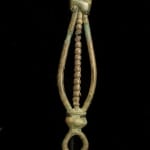Roman Bronze Pendant, 1 Century BCE - 4th Century CE
Bronze
6.5
SP.508
Further images
This bronze item may have served as a pendant of some sort. Due to the form of the item, which does not appear to open, its purpose is uncertain. Its...
This bronze item may have served as a pendant of some sort. Due to the form of the item, which does not appear to open, its purpose is uncertain. Its shape resembles a slender lyre, comprised of two snakes flanking a long, segmented spine. At the base is a circular shape from which the object may have hung on a chain or lanyard. Just below the snakes’ necks, they are constrained by a clasp of some sort. During fabrication, this component must have been fitted over the snakes’ heads and then their necks bent over to their current position. The item vaguely resembles a caduceus, a symbol associated with the god Hermes, which is also comprised of two snakes. This symbol has been often mistaken for the staff of Asclepius, comprised of only one snake, and in modern times it has been associated with the field of medicine, due to the formal similarity of the two symbols.
The snake was an animal that was sacred to several deities, including Asclepius, the god of healing. In Greco-Roman ideology, not yet influenced by Biblical connotations, the snake was symbolic of wisdom and even immortality, perhaps from the fact that it shed its skin as an act of renewal. In this charming artifact, whatever its original purpose, we come face to face with the ancients’ quest for immortality by way of their art and legends. Holding this in our hands, we confirm that their ideas have survived the ages and indeed achieved immortality.
The snake was an animal that was sacred to several deities, including Asclepius, the god of healing. In Greco-Roman ideology, not yet influenced by Biblical connotations, the snake was symbolic of wisdom and even immortality, perhaps from the fact that it shed its skin as an act of renewal. In this charming artifact, whatever its original purpose, we come face to face with the ancients’ quest for immortality by way of their art and legends. Holding this in our hands, we confirm that their ideas have survived the ages and indeed achieved immortality.





